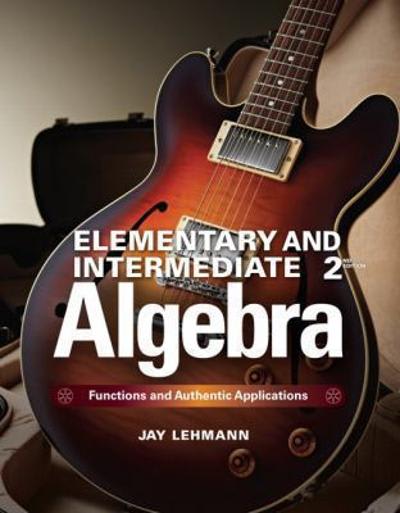Question
Central Tendency and Measures of Dispersion Background: given data for a sample of 18 adults in Ohio indicating the number of hours last week they
Central Tendency and Measures of Dispersion
Background:
given data for a sample of 18 adults in Ohio indicating the number of hours last week they spent watching Netflix.
These data are as follows: 14, 1, 7, 12, 0, 2, 0, 10, 13, 9, 3, 10, 1, 4, 13, 0, 3, 2.
[Proof of CALCULATIONS]
a.
Mean = ??
Median = ??
Mode = ??
Range = ??
Standard Deviation = ??
b.
Mean - type the interpretation.
Median - type the interpretation.
Mode - type the interpretation.
Range - type the interpretation.
Standard deviation - type the interpretation.
Do the different measures of central tendency lead you to different conclusions about the center of the distribution of data? What about the measures of dispersion?
c.
Based on the measures of central tendency above, what can you conclude about the skew of the distribution? In other words, is the distribution symmetric or is it skewed in some direction? Describe how you came to this conclusion.
2. Frequency Distributions & Measures of Central Tendency
Background:
A demographer is interested in comparing fertility patterns across national contexts. They are particularly interested in differences in number of children born per adult across the United States and Mexico. They collect data on a sample of people from Mexico (n = 990) and a sample of people from the U.S. (n = 1400) and ask how many children each person has. They organized the sample information in the frequency tables below:
Frequencies (f) | ||
| # of Children | Mexico | United States |
| 0 | 115 | 408 |
| 1 | 98 | 252 |
| 2 | 159 | 305 |
| 3 | 204 | 230 |
| 4 | 247 | 101 |
| 5 | 85 | 45 |
| 6 | 40 | 31 |
| 7 | 30 | 18 |
| 8 | 12 | 10 |
| Total | 990 | 1400 |
a. [Fill in the following table with percentages rounded to the hundredth, or second decimal place (e.g. 15.86%)]
| Mexico | United States | |||||||
| # of Children | Freq (f) | Rel. percent (%) | Cumul. percent (%) | # of Children | Freq (f) | Rel. percent (%) | Cumul. percent (%) | |
| 0 | 115 | 0 | 408 | |||||
| 1 | 98 | 1 | 252 | |||||
| 2 | 159 | 2 | 305 | |||||
| 3 | 204 | 3 | 230 | |||||
| 4 | 247 | 4 | 101 | |||||
| 5 | 85 | 5 | 45 | |||||
| 6 | 40 | 6 | 31 | |||||
| 7 | 30 | 7 | 18 | |||||
| 8 | 12 | 8 | 10 | |||||
| Total | 990 | Total | 1400 |
b. Is it appropriate to compare the raw frequencies in these frequency distributions between Mexico and the United States? Be sure to give an explanation that supports your answer.
c. [Hint: Must include an interpretation of the percentages, not just a list of numbers. Must provide at least two examples (e.g., 3 births and 0 births categories) for Mexico and the United States.]
d. [Use the table below to calculate the mean for both Mexico and the United States; you should be able to determine the mode and median using the relative and cumulative percentages from Part A]
| Mexico | United States | |||||
| # of Children | Freq (f) | x * f | # of Children | Freq (f) | x * f | |
| 0 | 115 | 0 | 408 | |||
| 1 | 98 | 1 | 252 | |||
| 2 | 159 | 2 | 305 | |||
| 3 | 204 | 3 | 230 | |||
| 4 | 247 | 4 | 101 | |||
| 5 | 85 | 5 | 45 | |||
| 6 | 40 | 6 | 31 | |||
| 7 | 30 | 7 | 18 | |||
| 8 | 12 | 8 | 10 | |||
| Total | 990 | 1400 |
Type interpretations of the mean, median, and mode Part D here.
Then, describe the main differences between the measures of central tendency for each country including a description of the skew of each distribution. What is the conclude about differences in the number of children that people have in Mexico and the United States?
3. Comparing Variation across Distributions
Background:
In addition to general differences in frequencies and measures of central tendency, the demographer from Problem 1 has asked us to determine which sample has greater variation in the number of childbirths: Mexico or the United States? The demographer calculated the following standard deviations for each distribution:
| Mexico | United States | |
| n | 990 | 1400 |
| s | 3.35 | 4.24 |
a. Write a sentence indicating which statistical value(s) are needed to compare the variation in both distributions. Be sure to explain why you must calculate these value(s).
SHOW CALCULATIONS
Don't forget to include a complete sentence explaining which distribution has greater variation.
Step by Step Solution
There are 3 Steps involved in it
Step: 1

Get Instant Access to Expert-Tailored Solutions
See step-by-step solutions with expert insights and AI powered tools for academic success
Step: 2

Step: 3

Ace Your Homework with AI
Get the answers you need in no time with our AI-driven, step-by-step assistance
Get Started


